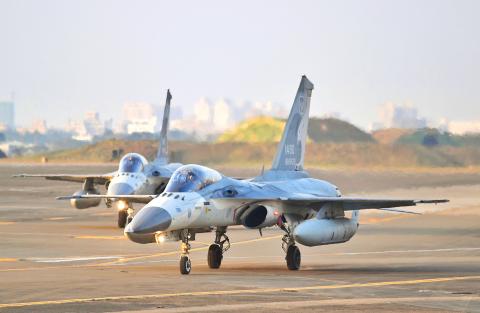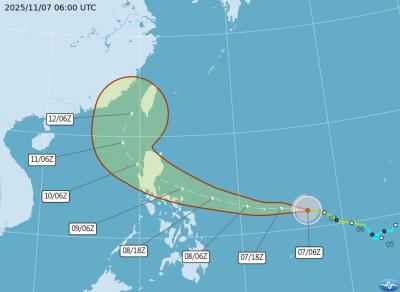The Ministry of National Defense has announced that it plans to develop a new generation of homegrown fighter jets with stealth capabilities as part of the government’s policy to develop an indigenous defense industry.
“Building homegrown aircraft and vessels has become an extremely important policy of the ministry since President Tsai Ing-wen (蔡英文) assumed office. Progress has been made in building indigenous vessels and there is another promise the ministry has to keep, which is to develop a new generation of fighter jets,” Minister of National Defense Feng Shih-kuan (馮世寬) said on Monday.
Feng made the announcement during a meeting with reporters, but did not give any details about the design or functions of the new aircraft.

Photo: CNA
According to reports, the new fighter jet is to be a double-engine stealth plane developed with Taiwanese technology.
The National Chung-Shan Institute of Science and Technology has reportedly been developing the engine technology based on the model fitted on the Indigenous Defense Fighter (IDF).
The air force’s Aviation Technology Research Center is also to be responsible for the development of the new fighter jets.
The research center, though receiving little public attention, is critical for refining the nation’s air defense capabilities in the next 10 to 20 years, Feng said.
While the nation is still seeking to procure F-35Bs, the short takeoff and vertical-landing variant of the US stealth jet that could satisfy the nation’s defense needs due to the vulnerability of air bases, Taiwan has to develop its own fighter jets to maintain its defense capabilities and increase the possibility of procurement, Feng said.
The development of homegrown fighter jets is key to the nation’s defense industry, as Aerospace Industrial Development Corp, which designed and built the IDF when it was an air force research division, is now the nation’s largest defense company, Feng said.
However, senior military analyst Erich Shih (施孝瑋) said that the IDF engine, with its inadequate thrust, could not be used to power next-generation fighter jets.
A capable engine on next-generation fighter jets should produce at least 24,000 pounds of thrust, but an IDF’s two engines can only produce up to 18,000 pounds of thrust, making the IDF engine unfit for the new jets, Shih said.
Since the development of the IDF in the 1990s, Taiwan has made little progress in military aviation or technological cooperation with other nations — such as an aborted plan to partner with an Italian manufacturer to build trainer jets for the air force — but building new jets is a more efficient option, both technologically and financially, to advance the nation’s aerospace industry, he said.

The Central Weather Administration (CWA) today issued a sea warning for Typhoon Fung-wong effective from 5:30pm, while local governments canceled school and work for tomorrow. A land warning is expected to be issued tomorrow morning before it is expected to make landfall on Wednesday, the agency said. Taoyuan, and well as Yilan, Hualien and Penghu counties canceled work and school for tomorrow, as well as mountainous district of Taipei and New Taipei City. For updated information on closures, please visit the Directorate-General of Personnel Administration Web site. As of 5pm today, Fung-wong was about 490km south-southwest of Oluanpi (鵝鑾鼻), Taiwan's southernmost point.

Tropical Storm Fung-Wong would likely strengthen into a typhoon later today as it continues moving westward across the Pacific before heading in Taiwan’s direction next week, the Central Weather Administration (CWA) said. As of 8am, Fung-Wong was about 2,190km east-southeast of Cape Oluanpi (鵝鑾鼻), Taiwan’s southernmost point, moving westward at 25kph and possibly accelerating to 31kph, CWA data showed. The tropical storm is currently over waters east of the Philippines and still far from Taiwan, CWA forecaster Tseng Chao-cheng (曾昭誠) said, adding that it could likely strengthen into a typhoon later in the day. It is forecast to reach the South China Sea

Almost a quarter of volunteer soldiers who signed up from 2021 to last year have sought early discharge, the Legislative Yuan’s Budget Center said in a report. The report said that 12,884 of 52,674 people who volunteered in the period had sought an early exit from the military, returning NT$895.96 million (US$28.86 million) to the government. In 2021, there was a 105.34 percent rise in the volunteer recruitment rate, but the number has steadily declined since then, missing recruitment targets, the Chinese-language United Daily News said, citing the report. In 2021, only 521 volunteers dropped out of the military, the report said, citing

Nearly 5 million people have signed up to receive the government’s NT$10,000 (US$322) universal cash handout since registration opened on Wednesday last week, with deposits expected to begin tomorrow, the Ministry of Finance said yesterday. After a staggered sign-up last week — based on the final digit of the applicant’s national ID or Alien Resident Certificate number — online registration is open to all eligible Taiwanese nationals, foreign permanent residents and spouses of Taiwanese nationals. Banks are expected to start issuing deposits from 6pm today, the ministry said. Those who completed registration by yesterday are expected to receive their NT$10,000 tomorrow, National Treasury